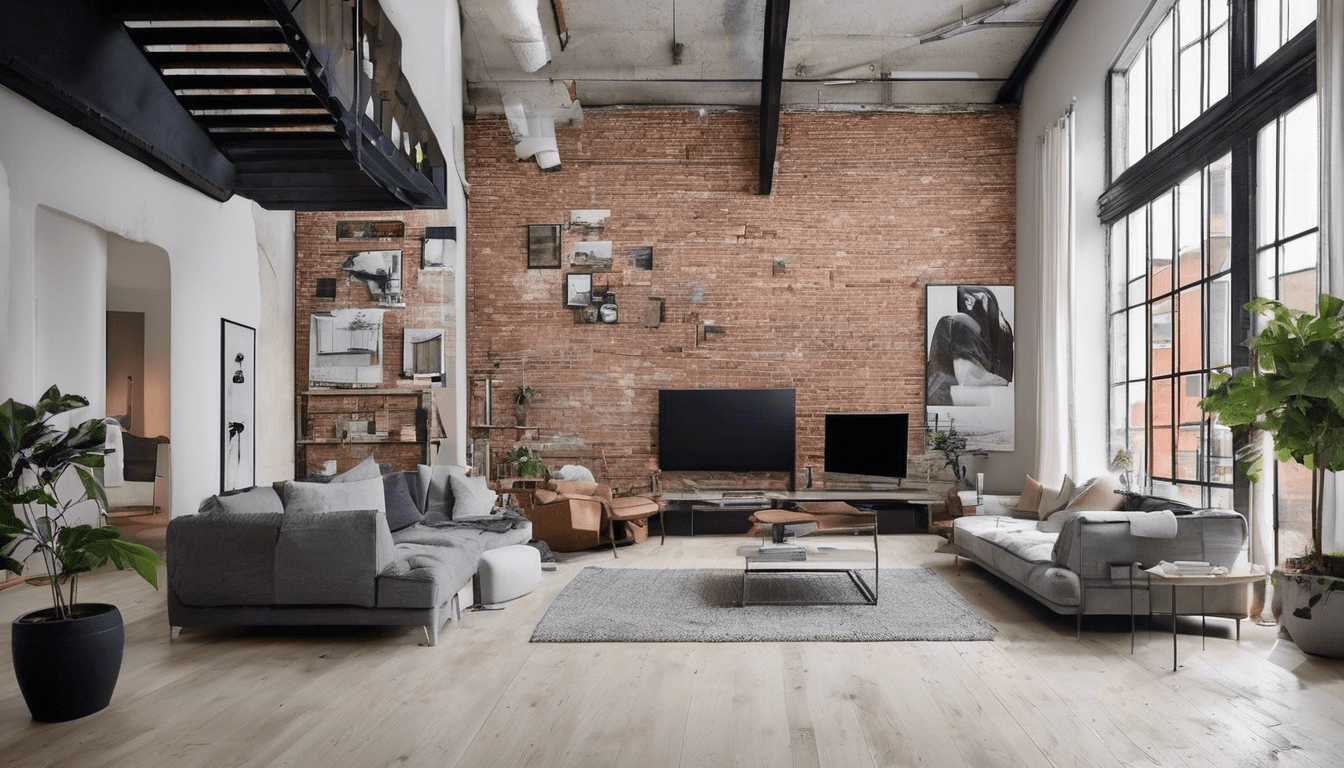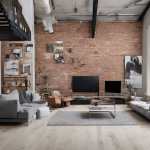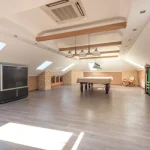Transforming your loft offers more than extra space; it’s an opportunity to redefine your home’s style and efficiency in 2025. This guide explores innovative design strategies—like open layouts, natural lighting, and sustainable materials—that maximize functionality while reflecting current trends. By reimagining your loft, you can boost property value, enhance daily comfort, and create a stylish retreat that stands the test of time.
Maximizing Space with Modern Loft Design
Optimizing loft space is essential in modern home design to make the most of every square foot. Innovative layout options focus on maximizing usable space by combining functionality with style. For example, creating an open-plan loft design not only enhances natural light but also improves airflow, making the area feel larger and more inviting.
Also to discover : Ultimate loft conversions guide: transform your space in 2025
One of the key space-saving ideas is the integration of multi-functional furniture. Items such as beds with built-in storage drawers, fold-away desks, or sofas that double as guest beds can significantly reduce clutter. Incorporating clever storage solutions—like under-stairs cupboards or custom shelving—further optimizes the loft’s footprint without compromising aesthetics.
Open-plan layouts in loft conversions are particularly valuable. Removing unnecessary partitions allows daylight to flow freely, amplifying the sense of spaciousness. This approach also provides flexibility for different uses, from a cozy office corner to a minimalist lounge area. By thoughtfully combining these elements, homeowners can truly elevate their loft space into a versatile and comfortable extension of their living areas.
Topic to read : 5 Reasons to Consider Routine Antique Grandfather Clock Servicing
Incorporating Natural Light and Ventilation
Bright, well-ventilated loft spaces transform your home, improving comfort and energy efficiency. Natural light is vital in loft conversions, creating an open and inviting atmosphere. Installing large windows and strategically positioned skylights allows sunlight to flood the room during the day, reducing the need for artificial lighting.
Skylights are particularly effective; they bring daylight into the heart of the loft where traditional windows may not fit. Choosing the right size and type of loft windows ensures optimal brightness while maintaining the architectural charm of your space. Moreover, the placement of these windows affects how much sunlight you receive — for instance, south-facing skylights typically capture more direct sunlight, brightening your loft throughout the day.
Ventilation goes hand in hand with natural light to ensure good air quality. A smart ventilation system can help regulate airflow, preventing dampness and stale air, which are common concerns in loft conversions. These systems often include vents and fans that extract warm, moist air and draw in fresh air, maintaining a healthy environment year-round.
When planning light and ventilation, it’s crucial to consider privacy. Well-placed loft windows can prevent overlooking from neighbors while still allowing ample light and airflow. Using frosted glass or window treatments can further enhance privacy without sacrificing illumination. Thoughtful integration of natural light, ventilation, and privacy ensures your loft conversion remains a comfortable, enjoyable space. For more details on optimizing your space, see our comprehensive loft conversions guide.
Trending Interior Styles for 2025 Loft Conversions
When planning a loft conversion, staying ahead of interior design trends enhances both style and functionality. For 2025, three standout loft aesthetics promise to transform spaces beautifully.
Minimalist and Scandinavian Influences
Minimalism continues to dominate, emphasizing clean lines, uncluttered layouts, and a focus on natural light. Scandinavian influences add warmth through muted tones, purposeful furniture, and cozy textiles. This style relies on simplicity but does not sacrifice comfort or practicality. Loft conversions embracing this trend often feature white walls, light wood floors, and large windows to maximize brightness. The result is an airy, calm environment perfect for small or large loft spaces.
Industrial Chic and Exposed Elements
Industrial chic remains a popular loft aesthetic, characterized by exposed brick walls, visible ductwork, and raw metal fixtures. This style blends functionality with edgy urban charm. It suits loft conversions that want to celebrate their architectural character rather than hide it. The style often includes open shelving, distressed wood, and vintage lighting. This choice creates a bold, modern statement while preserving the space’s original features.
Eco-Friendly and Sustainable Materials
Eco-conscious design is among the top interior design trends for 2025. Loft conversions increasingly incorporate sustainable materials such as reclaimed wood, bamboo flooring, and low-VOC paints. Choosing these materials reduces environmental impact while adding unique textures and colors to home decor. Beyond materials, energy-efficient lighting and smart insulation systems support sustainability goals in loft renovations. Homeowners looking to combine style with responsibility will find this approach very rewarding.
By integrating these trends, loft conversions can be both stylish and future-proof. For more inspiration on maximizing loft potential, explore this comprehensive loft conversions guide.
Cost-Effective Loft Conversion Ideas
Planning a budget-friendly loft conversion starts with careful cost planning. One of the most impactful decisions is selecting affordable renovation materials and finishings without sacrificing style or durability. Opting for materials like laminated flooring or reclaimed wood can significantly reduce costs. Similarly, using plasterboard instead of more expensive wall cladding helps keep the budget manageable, allowing you to allocate funds to other parts of the project.
Choosing Material and Finishings for Value
When choosing materials and finishings, aim for products that offer a good balance between cost and longevity. For example, vinyl flooring is an affordable option that mimics the look of hardwood but requires less maintenance. Painting walls instead of wallpapering can also reduce initial expenses. Incorporating natural light through strategically placed windows can make the space feel larger and more inviting without expensive structural changes, thus enhancing overall value.
DIY Versus Professional Installation
A common question is whether to undertake a loft conversion DIY or hire professionals. While DIY can save on labor costs, it often requires advanced skills and substantial time commitment. Incorrect installation may lead to increased expenses later due to repairs. Conversely, hiring experienced contractors ensures compliance with building regulations and quality workmanship. A balanced approach is to handle simpler tasks yourself, like painting or finishing touches, and leave structural elements to experts to prevent costly mistakes.
Potential Cost Savings on Structural Changes
Reducing the need for major structural modifications is a smart way to keep a loft conversion affordable. Many loft conversions benefit from existing frameworks, such as using current roof lines and floor joists. Avoiding complex changes like extending the roof or reinforcing foundations significantly lowers costs. Another cost-saving tip is to make use of standard-sized windows and doors instead of custom sizes, which can be pricier. Strategically planning these elements aids in creating a modern and functional space while maintaining control over your renovation budget.
Enhancing Home Value and Future Benefits
Loft conversions are widely recognized for their substantial property value increase potential. By transforming unused attic space into functional rooms, homeowners can significantly boost the overall market price of their property. This upgrade is especially appealing in competitive real estate markets where additional living space often translates directly into higher offers.
When considering the investment benefits of a loft conversion, it’s essential to evaluate the return on investment (ROI). Typically, these conversions recoup a large percentage of their costs upon sale, often ranging between 70% to 85% ROI. This strong ROI makes loft conversions one of the most effective home improvements for enhancing resale value.
From the perspective of potential buyers, loft conversions create functional spaces that enhance livability and appeal. These spaces can be adapted into bedrooms, offices, or leisure areas, aligning with diverse lifestyle needs. By offering flexible utility, loft conversions help properties stand out without requiring additional land purchase.
Long-term maintenance and upkeep considerations are also essential. Proper insulation, ventilation, and access points installed during the conversion process ensure the new living area remains comfortable and energy-efficient. Regular maintenance on these elements safeguards property value and prevents costly repairs, preserving the investment benefits over time.
Exploring a loft conversions guide can help homeowners understand how to maximize these benefits while addressing practical aspects related to design and compliance. By doing so, it’s possible to enhance both the immediate and long-term value of your home effectively.
Before-and-After Transformation Examples
Discover the striking impact of loft conversions through vivid Loft Conversion Before and After images that tell a story of transformation and ingenuity.
When exploring successful loft remodels, it’s vital to note the role of Renovation Highlights such as enhanced natural light, clever storage solutions, and the introduction of multifunctional spaces. These elements not only boost a home’s practicality but also elevate its aesthetic appeal. Visual Inspiration from recent projects in 2025 showcases contemporary trends emphasizing open layouts, minimalist finishes, and energy-efficient materials.
One common question is: What specific changes define the most impressive loft conversion before and after results? The precise difference often hinges on structural modifications like installing skylights, reinforcing floors for new rooms, and integrating modern insulation. These renovations profoundly shift both the feel and function of the space. Beyond appearance, they improve thermal comfort and property value.
In addition, the design elements that transformed spaces include neutral color palettes combined with strategic accent lighting, which together create warm, inviting atmospheres. Incorporating built-in furniture maximizes space usage, while large windows frame outdoor views, further expanding the perceived room size.
Studying lessons from recent renovations reveals the importance of thorough planning and quality craftsmanship in achieving lasting success. Homeowners who focused on professional project management and clear communication with contractors avoided common pitfalls such as delays or budget overrun.
For those eager to visualize these concepts in action and plan their own projects, a detailed loft conversions guide can provide comprehensive steps and inspiration. The journey from a bare attic to a stylish, functional living area exemplifies how thoughtful design and execution merge to transform a house profoundly.
Practical Tips for Planning and Implementing a Loft Conversion
Ensuring a smooth and successful transformation
Navigating Planning Permissions and Building Codes
Understanding loft conversion planning begins with grasping the importance of planning permissions and building regulations. Most loft conversions require adherence to local building regulations to guarantee safety and structural integrity. It is essential to consult with your local planning authority early to determine whether your project needs formal planning permission or falls under permitted development rights. These regulations often cover aspects such as fire safety, insulation, ventilation, and escape routes.
To address common questions using the SQuAD method:
Q: Do all loft conversions require planning permission?
A: Not necessarily. Some loft conversions qualify as permitted development, which means they can proceed without formal planning permission—provided they comply with building regulations and do not extend beyond stipulated size limits or affect certain protected properties.
Building regulations approval is a separate process ensuring your loft adheres to safety and quality standards. Engaging a qualified surveyor or architect during the loft conversion planning phase aids in navigating these rules efficiently.
Selecting the Right Contractors and Designers
Choosing experienced contractors and designers is crucial for successful loft conversion planning and execution. Ask for credentials, previous project examples, and references to verify their expertise. UK’s building regulations mandate that all structural alterations be performed to certified standards — hiring professionals familiar with this protects you from costly errors or delays.
Involving an architect or designer early contributes innovative yet practical ideas that optimize your loft’s space and comply with regulations. Coordinating clear communication between you, your designer, and contractor helps reduce misunderstandings and secures a workflow aligned with your vision.
Timeline and Budget Management Strategies
Effective project management is indispensable for loft conversion planning. First, establish a detailed timeline that accommodates each phase: design, permissions, contracting, construction, and finishing. Realistic timelines reduce stress and allow for unforeseen delays caused by weather or material availability.
Budget management should focus on transparency and contingencies. Obtain multiple quotes to compare costs fairly, considering both labour and materials. Systematically tracking expenses as the project progresses avoids unpleasant surprises. It is prudent to allocate a contingency fund of around 10-15% of the total budget to cover unexpected costs.
In sum, successful loft conversion planning hinges on thorough knowledge of building regulations, intelligent choice of contractors and designers, and disciplined project and budget management. These components work together to transform your loft efficiently and safely, enhancing your home’s value and usability.
Future-Oriented Design Features for 2025
Smart home integration is no longer a luxury but an essential element in modern loft conversions. Future-proof designs emphasize compatibility with evolving technologies, ensuring your loft remains cutting-edge for years. By embracing tech-enhanced lofts, homeowners unlock convenience, efficiency, and enhanced lifestyle benefits.
Incorporating Smart Lighting and Climate Control
How can smart lighting and climate control improve your loft space? Smart lighting systems use sensors and programmable settings to adjust brightness and color temperature based on time of day or activity. This not only enhances ambiance but also helps conserve energy.
Climate control technologies, such as smart thermostats, maintain optimal temperature by learning your preferences and adjusting heating or cooling accordingly. This results in consistent comfort and significant energy savings. Integrating these systems within your loft conversion creates a responsive environment tailored to your daily needs.
Using Technology to Optimize Space and Functionality
What role does technology play in maximizing loft functionality? Tech-enhanced lofts feature modular furniture and automated storage solutions that adapt to different uses. For example, motorized shelving can retract to reveal additional living or workspace, while smart home controls manage room usage and lighting to create versatile areas.
Furthermore, incorporating wireless charging stations and connectivity hubs enables seamless device use and reduces cable clutter. This thoughtful use of technology transforms your loft into a highly functional, organized, and adaptable space.
Sustainability and Energy Efficiency Innovations
Future-proof designs prioritize sustainability by integrating energy-efficient appliances, advanced insulation materials, and renewable energy sources such as solar panels. These innovations reduce environmental impact and lower utility costs over time.
Smart home integration contributes by monitoring energy usage and providing actionable insights to optimize consumption. For example, real-time tracking allows homeowners to identify energy spikes and adjust behavior or settings. Sustainable and energy-efficient features combined with intelligent systems make your loft not only environmentally responsible but also cost-effective in the long term.











